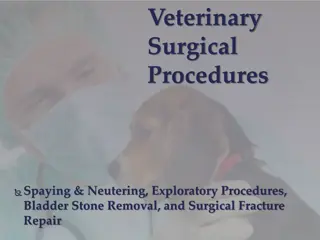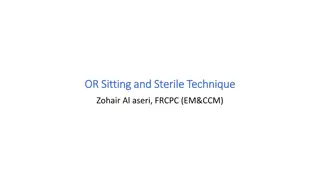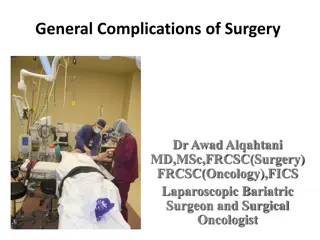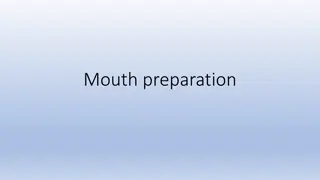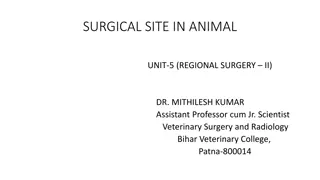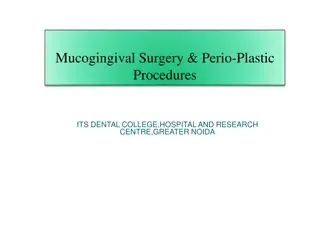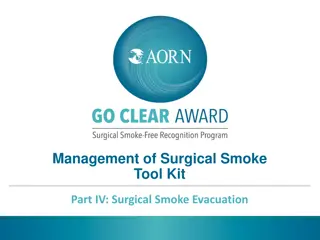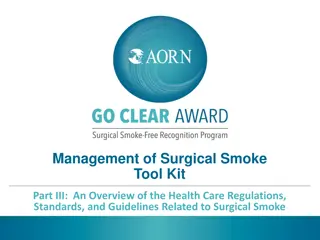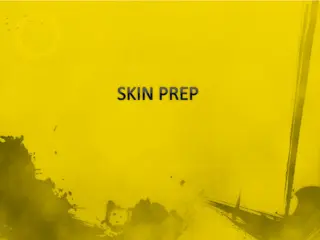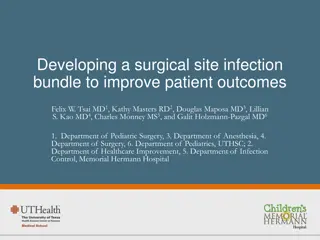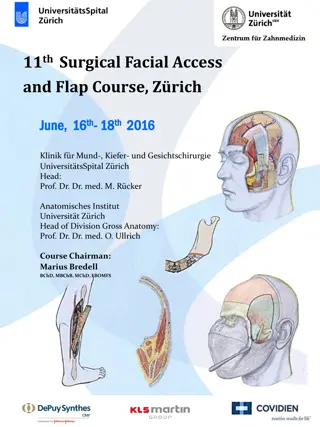Comprehensive Guide to Surgical Procedures Preparation
This detailed guide provides step-by-step instructions on patient preparation for surgical procedures, including patient prep, setting up sterile fields, and prepping the operative site. It covers essential aspects such as emplacing a tourniquet, washing the wound, performing preoperative irrigation, preparing for a sterile procedure, and painting the operative site. Following these guidelines ensures a sterile and safe surgical environment.
Download Presentation

Please find below an Image/Link to download the presentation.
The content on the website is provided AS IS for your information and personal use only. It may not be sold, licensed, or shared on other websites without obtaining consent from the author.If you encounter any issues during the download, it is possible that the publisher has removed the file from their server.
You are allowed to download the files provided on this website for personal or commercial use, subject to the condition that they are used lawfully. All files are the property of their respective owners.
The content on the website is provided AS IS for your information and personal use only. It may not be sold, licensed, or shared on other websites without obtaining consent from the author.
E N D
Presentation Transcript
SURGERY Guide to Procedures
Topics Patient prep Debridement Closure Amputation Fasciotomy
Patient Prep Emplace tourniquet but do not inflate. You can inflate it later if major bleeding occurs Remove bandage Wash wound and extremity Chux pads may be placed underneath pt. to collect excess fluids (remember to change them out after they get wet) The wound and entire extremity needs to be thoroughly scrubbed (think of it as your hand and arm scrub before gowning)
Patient Prep Wash wound and extremity Dirty areas like the foot and perineum (axilla and hand for arms) should also be scrubbed even though they will be covered by drapes, because of the proximity to the sterile area Once area is scrubbed, this is a good time to do the bulk of preoperative irrigation This irrigation is mainly directed to the wound Good retraction and gentle massage We re not worried about a little soap on the rest of the extremity
Patient Prep Prepare for sterile procedure Everyone in proper uniform Hat, mask, clean shoes or shoe covers Doors shut Limit entrance into OR Open only the outer wraps of sterile packs Gown, gloves, surgical pack Perform hand and arm (surgical) scrub
Patient Prep Set up sterile fields Gown and glove Open and organize sterile fields Exercise economy of motion, supplies and time Get everything ready because your assistant will be unavailable when he will be supporting the extremity It may be better to have the assistant open the individual sterile packets and allow the surgeon to grab and place the sterile items on the field than trusting the assistant to flip them onto the fields himself
Patient Prep Prepping the operative site Painting the extremity should start with the wound and work outward to the peripheral extremity It s not a big issue if the assistant s gloved hand touches a part of the painted extremity while it is wet Remember that everything around you is unsterile Be conscious of your surroundings and where your hands and gown are
Patient Prep Prepping the operative site Draping is then applied in order to accomplish 3 things, airtight from space below the draping, waterproof surrounding the operative area and a large enough work space for ease of the procedure Airtight 1 or 2 sterile hand towels placed tightly around the proximal thigh and clamp Waterproof 3 or 4 steri drapes placed over the hand towels Working area Bottom drape, top drape, splice in the sides and clamp Distal drape - Sterile Coban, sterile towel or sterile glove
Patient Prep Prepping the operative site Drapes should be placed deliberately and directly, not flipped or thrown into place Once again, nothing is sterile around you Be conscious of where your hands are Prior to incising/excising, the wound should be irrigated again to flush out residual contaminants and antiseptic solutions (antiseptics are toxic to tissues as well as staining them, making assessment difficult)
Debridement The wound is extended with a scalpel enough to expose the extent of the injury and allow for decompression of the wound The skin edge surrounding the original wound (not the surgical incisions) is excised minimally with a scalpel Dissecting scissors are not preferred for cutting skin Undermining the skin is only necessary if the injury extends underneath it
Debridement Subcutaneous fascia is incised with dissecting scissors to at least the same length of skin incision Affected muscles should be bluntly separated from adjoining muscles, then inspected in their entirety Use escalation of force while doing this Be as gentle as possible All necrotic, contused and contaminated tissues excised (4 C s)
Debridement Any fat encountered excised generously Work with a systematic approach Address vessels as encountered Transfix vessels with potential for moderate bleeding Irrigate and inspect entire wound Look in all nooks and crannies Missed culture medium For any bleeding and ensure all ligations are secure
Debridement Final irrigation (1-3L or until it looks clean) Dry, apply pressure Dress with an abundance of gauze Initial layer to have complete contact with tissues Follow with some fluffed gauze Continue antibiotic treatment for 5 days from injury or until closure (no more than 5 days)
Debridement Dressing (advised for caprine model) V-shape stack of 4x8s (thick enough to collect fluid for wound size) Suture proximally with 4-6 sutures of 0 silk Place webril over 4x8s and entire leg for both absorption and padding for splint Place elastic stocking over webril and staple proximally Place and form splint and affix with coban
Closure 4 - 6 Days after Debridement Prep and drape as usual Inspect for necrotic tissue, adhesions, signs of infection (thorough inspection) If only a small amount of necrotic tissue is present, it may be removed If there were no signs of infection, the wound may be closed
Closure Collagen (if present) can be scraped off with gauze or the back end of tissue or Adson forceps Any sign of infection, the wound should not be closed When is doubt, leave sutures out
Closure Skin excision should be limited only to areas which will create defects Determine wound approximation and undermine prn In areas of tension, undermining no more than 5 cm from wound edge can be helpful Wound irrigated, inspected, final irrigation and dried
Closure Wound can be closed with wound edges approximated and everted with forceps Under no circumstance will the wound be closed under tension (use ROM to determine differences of tension) If undermining will not suffice, the use of MRSI can be used Not over undermined area Depth of incision through entirety of dermis
Closure Roll the wound to express any residual fluids and help with apposition Dress with gauze and suture (0 silk) on its proximal end (caprine model) Cover with elastic stocking stapled proximally (caprine model) If a drain is placed it should be removed within 24 hrs if not draining substantial exudates >20ml in 24hr period is substantial
Closure Dressings the idea is not necessarily that the same dressing stays in place until suture removal, but that the wound remain protected by a dressing until suture removal. Of course, the dressing should be changed if the dressing becomes saturated and/or soiled. A little dirt on the exterior of the elastic stocking does not indicate that underneath the dressing is soiled.
Closure Secondary intent Dressing changes and gentle washing Q4-5D Use of vessel loops/sterile rubber bands (Jacobs ladder) help to keep skin from retraction In cases of infection: Daily sugar or honey dressings and copious washing until infection subsides Institute antibiotic regimen Re-excise as needed Switch to infrequent dressing changes once infection is under control (Q4-5D)
Amputation If it is a partial amputation which has a significant amount of tissues attaching the distal extremity, it should be scrubbed in If it is basically a complete amputation and only hanging on by 1 or 2 tendons or just a small amount of skin, then it can be removed prior to preparation Once scrubbed in, the focus is on performing the amputation and not on the non-viable distal extremity
Amputation Tourniquet placed and inflated Document time and order time hacks Extremity prepared and draped as usual First step is to assess level of amputation Next, create skin flaps by incising all the way through the dermis and deep fascia Only reflect skin flaps proximally if needed to allow access/exposure Do not de-glove entire stump Incise fascia over muscles
Amputation Blunt dissect to mobilize the whole (unaffected) muscle to be used as the myoplasty and section at distal attachment Reflect this muscle proximally, slightly past the point of where the bone is to be sectioned
Amputation Section all other muscles at the point or slightly distal to where the bone is to be sectioned. Reflect the sectioned muscles proximally, slightly past the point where the bone is to be sectioned Do not strip periosteum proximally or distally
Amputation Score periosteum (to include bevel on tibia for BKA) and section bone Keep gigli saw blade between a 90 - 180 degree angle Let the saw blade do the work Have assistant hold good tissue out of the way File or rasp sharp corners (bevel the edges) Always rasp toward the medullary canal Locate vessels and address them Transfix all vessels that have the potential for moderate bleeding
Amputation Remove tourniquet and check for hemorrhage control Performed right after vessel ligations - 90 minute tourniquet time! Locate all named nerves and address them By sharp dissection, proximally as possible No need to crush or inject them Look for any tissues under fascial tension and relieve it
Amputation Irrigate, final look and ensure hemostasis All nooks and crannies, ligations Final Irrigation, dry and dress Do not suspend skin flaps (do not place gauze between skin flaps and underlying tissue) Lots of absorbant bulk needed for stump dressing Need to account for an extreme amount of serosanguinous drainage
Amputation Post op Splinted in extension Stump elevated and rested first 48 hrs Mobility started ASAP Gentle ROM directed at extension of the joint(s) above after the rest period Both passive and active Should not harm the wound or dressing
Amputation Closure Prepared as usual Suture whole muscle over bone by anchoring to periosteum and muscles (whatever you have) You are suturing this muscle to stay in place, not just placing a few tack sutures Place drain Close skin flaps incorporating deep fascia Combination of vertical mattress and simple interrupted
Amputation Post-Op care Same as previous until suture removal Drain removed at 48 hours or when drainage is < 20ml in a 24hr period After suture removal, physical therapy progresses and elastic stump bandaging can be applied (figure 8 wrap using 50% stretch of the elastic)
Amputation Secondary Closure Either complete secondary closure or partial secondary closure: Use of vessel loops or sterile rubber bands (Jacob's ladder) can be used to prevent skin retraction Infrequent dressing changes every 4-5 days with a gentle wash/irrigation
Fasciotomy Prepare extremity as usual if time permits May need to be performed STAT Make as sterile as possible S/Sx will dictate urgency
Fasciotomy Lower Leg Procedure (anterior and lateral) Incise laterally through dermis one finger in front of fibula, from three finger breadth distal to fibular head to 3 finger breadth proximal from lateral malleolus Locate intermuscular septum between anterior and lateral compartments Make "H" incision, first by incising (with scalpel) across the septum to ensure it is the septum (be cautious of superficial peroneal nerve)
Fasciotomy Lower Leg Procedure Make the legs of the "H" proximally and distally by incising (with dissecting scissors) over both the anterior and lateral compartments Lift the fascial up from the underlying tissue by running the closed scissors underneath the fascia prior to incising Incise by pushing through the fascia with slightly open scissors Do not use clipping action Keep scissor curve pointed away from septum
Fasciotomy Lower Leg Procedure (superficial and deep posterior) Incise medially through dermis one thumb breadth posterior to the tibial border, from three finger breadth distal to tibial plateau to 3 finger breadth proximal from medial malleolus Exercise caution to avoid cutting the saphenous vein Incise fascia over superficial compartment Avoid saphenous vein Be prepared to ligate saphenous tributaries
Fasciotomy Lower Leg Procedure (superficial and deep posterior) Locate soleus muscle and remove its attachment to the tibia by blunt or sharp dissection You should be able to visualize the Posterior Tibial neurovascular bundle between the superficial and deep posterior compartments Incise fascia overlying the deep posterior compartment
Fasciotomy Forearm Incision through the skin will start either on the medial or lateral side of the upper arm heading distally At the elbow, the incision should be obliquely across the crease Caution with cephalic vein It should then be carried out to the wrist, where once again continued obliquely (v-shaped) to the Thenar space
Fasciotomy Forearm Fascial incisions to open the superficial volar, deep volar and mobile wad can be accomplished with this skin incision The bicepital aponeurosis (lacertus fibrosis) also needs to be released Caution with brachial artery and median nerve Bicepital aponeurosis
Fasciotomy Forearm A skin incision over the extensor muscles on the posterior aspect of the forearm will provide access to the dorsal compartment Irrigate, final inspection and final irrigation Dry and dress No constriction Keep extremity at the level of heart Delayed Primary Closure or Secondary Intent





